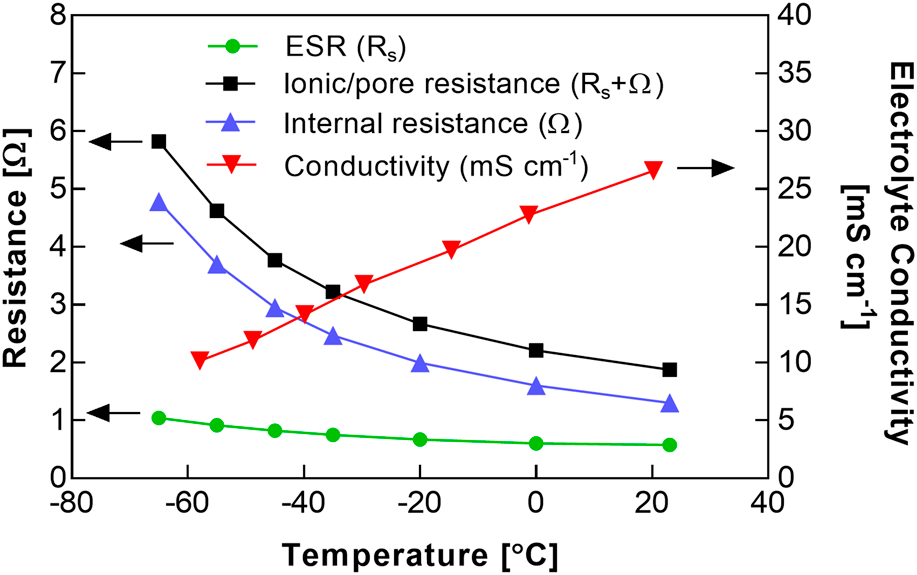Crossref Citations
This article has been cited by the following publications. This list is generated based on data provided by
Crossref.
Wang, Wei
Xie, Wan-Yun
Zhou, Fei-Xiang
Chen, Liang
Zhou, Minjie
Wang, Guo-Xiang
Xu, Wenyuan
and
Liang, Enxiang
2021.
Three-dimensional nitrogen-doped graphene hydrogel-based flexible all-solid-state supercapacitors.
Journal of Materials Research,
Vol. 36,
Issue. 2,
p.
376.
Chodankar, Nilesh R.
Patil, Swati J.
Hwang, Seung Kyu
Karekar, Smita V.
Jayaramulu, Kolleboyina
Zhang, Wenli
Dubal, Deepak P.
Huh, Yun Suk
and
Han, Young-Kyu
2021.
Supercapacitors operated at extremely low environmental temperatures.
Journal of Materials Chemistry A,
Vol. 9,
Issue. 47,
p.
26603.
Hung, Pui-yan
Zhang, Huihui
Lin, Han
Guo, Qiaoshi
Lau, Kin-tak
and
Jia, Baohua
2022.
Specializing liquid electrolytes and carbon-based materials in EDLCs for low-temperature applications.
Journal of Energy Chemistry,
Vol. 68,
Issue. ,
p.
580.
Wang, Yao
Wei, Hua
Li, Zhengtai
Zhang, Xiangyong
Wei, Zhiquan
Sun, Ke
and
Li, Hongfei
2022.
Optimization Strategies of Electrolytes for Low‐Temperature Aqueous Batteries.
The Chemical Record,
Vol. 22,
Issue. 10,
Sengupta, Shilpi
and
Kundu, Manab
2023.
Sustainable Energy Storage in the Scope of Circular Economy.
p.
145.
Lakshmi, K. C. Seetha
and
Vedhanarayanan, Balaraman
2023.
High-Performance Supercapacitors: A Comprehensive Review on Paradigm Shift of Conventional Energy Storage Devices.
Batteries,
Vol. 9,
Issue. 4,
p.
202.
Bayona-Becerra, Mayra
Aceros-Cabezas, Jhon
Güiza-Argüello, Viviana
and
Blanco, Sergio
2023.
A direct and low-cost approach to synthesizing SiC/C foams from renewable sources for energy storage applications.
MRS Communications,
Vol. 13,
Issue. 2,
p.
240.
Nikiforidis, Georgios
Phadke, Satyajit
and
Anouti, Mérièm
2023.
Comparative Internal Pressure Evolution at Interfaces of Activated Carbon for Supercapacitors Containing Electrolytes Based on Linear and Cyclic Ammonium Tetrafluoroborate Salts in Acetonitrile.
Advanced Materials Interfaces,
Vol. 10,
Issue. 2,
Zhang, Kun
Wang, Congwei
Luo, Xinglin
Pan, Yuede
Li, Gang
and
Wang, Kaiying
2024.
Progress on Engineering Low-Temperature Electrolyte for High-Performance Supercapacitors.
ACS Sustainable Chemistry & Engineering,
Vol. 12,
Issue. 16,
p.
6059.
Lan, Shuqin
Yu, Chang
Yu, Jinhe
Zhang, Xiubo
Liu, Yingbin
Xie, Yuanyang
Wang, Jianjian
and
Qiu, Jieshan
2024.
Recent Advances in Low‐Temperature Liquid Electrolyte for Supercapacitors.
Small,
